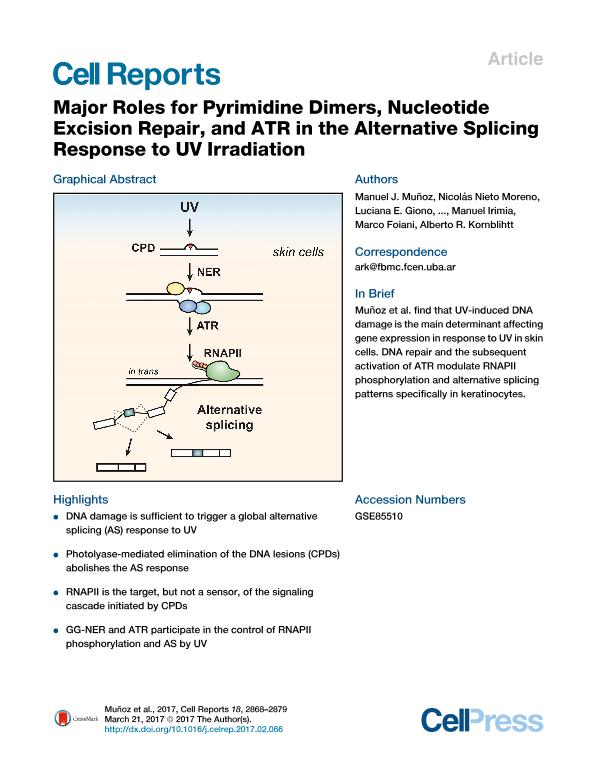Artículo
Major roles of for pyrimidine dimers, nucleotide excision repair and ATR in the alternative splicing response to UV irradiation
Muñoz, Manuel Javier ; Nieto Moreno, Nicolás
; Nieto Moreno, Nicolás ; Giono, Luciana Eugenia
; Giono, Luciana Eugenia ; Cambindo Botto, Adrian Edgardo
; Cambindo Botto, Adrian Edgardo ; Dujardin, Gwendal; Bastianello, Giulia; Lavore, Stefania; Torres-Méndez, Antonio; Menck, Carlos FM; Blencowe, Benjamin; Irimia, Manuel; Foiani, Marco; Kornblihtt, Alberto Rodolfo
; Dujardin, Gwendal; Bastianello, Giulia; Lavore, Stefania; Torres-Méndez, Antonio; Menck, Carlos FM; Blencowe, Benjamin; Irimia, Manuel; Foiani, Marco; Kornblihtt, Alberto Rodolfo
 ; Nieto Moreno, Nicolás
; Nieto Moreno, Nicolás ; Giono, Luciana Eugenia
; Giono, Luciana Eugenia ; Cambindo Botto, Adrian Edgardo
; Cambindo Botto, Adrian Edgardo ; Dujardin, Gwendal; Bastianello, Giulia; Lavore, Stefania; Torres-Méndez, Antonio; Menck, Carlos FM; Blencowe, Benjamin; Irimia, Manuel; Foiani, Marco; Kornblihtt, Alberto Rodolfo
; Dujardin, Gwendal; Bastianello, Giulia; Lavore, Stefania; Torres-Méndez, Antonio; Menck, Carlos FM; Blencowe, Benjamin; Irimia, Manuel; Foiani, Marco; Kornblihtt, Alberto Rodolfo
Fecha de publicación:
21/03/2017
Editorial:
Elsevier B.V.
Revista:
Cell Reports
ISSN:
2211-1247
Idioma:
Inglés
Tipo de recurso:
Artículo publicado
Clasificación temática:
Resumen
We have previously found that UV irradiation promotes RNA polymerase II (RNAPII) hyperphosphorylation and subsequent changes in alternative splicing (AS). We show now that UV-induced DNA damage is not only necessary but sufficient to trigger the AS response and that photolyase-mediated removal of the most abundant class of pyrimidine dimers (PDs) abrogates the global response to UV. We demonstrate that, in keratinocytes, RNAPII is the target, but not a sensor, of the signaling cascade initiated by PDs. The UV effect is enhanced by inhibition of gap-filling DNA synthesis, the last step in the nucleotide excision repair pathway (NER), and reduced by the absence of XPE, the main NER sensor of PDs. The mechanism involves activation of the protein kinase ATR that mediates the UV-induced RNAPII hyperphosphorylation. Our results define the sequence UV-PDs-NER-ATR-RNAPII-AS as a pathway linking DNA damage repair to the control of both RNAPII phosphorylation and AS regulation.
Archivos asociados
Licencia
Identificadores
Colecciones
Articulos(IFIBYNE)
Articulos de INST.DE FISIOL., BIOL.MOLECULAR Y NEUROCIENCIAS
Articulos de INST.DE FISIOL., BIOL.MOLECULAR Y NEUROCIENCIAS
Citación
Muñoz, Manuel Javier; Nieto Moreno, Nicolás; Giono, Luciana Eugenia; Cambindo Botto, Adrian Edgardo; Dujardin, Gwendal; et al.; Major roles of for pyrimidine dimers, nucleotide excision repair and ATR in the alternative splicing response to UV irradiation; Elsevier B.V.; Cell Reports; 18; 12; 21-3-2017; 2868-2879
Compartir
Altmétricas



